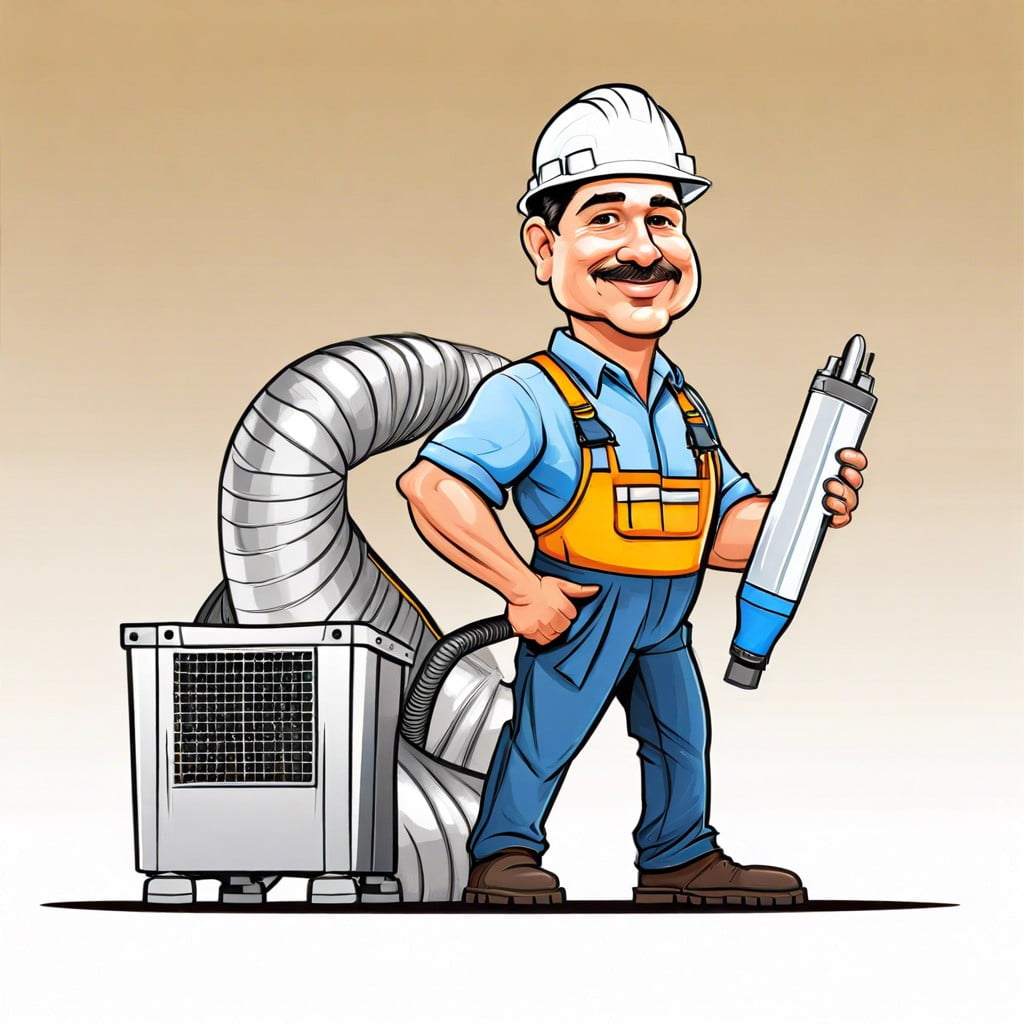Learn how to clean your air ducts step-by-step to improve your home’s air quality and enhance HVAC efficiency.
Key takeaways:
- Thoroughly inspect ducts for dust, mold, pests, and odors.
- Use a negative pressure vacuum to clean ducts effectively.
- Clean HVAC system components like filters, coils, and blower motors.
- Look for certification, experience, references, and fair pricing when hiring a duct cleaner.
- Beware of scams like lowball quotes, cheap and superficial cleaning, scare tactics, fake credentials, bait and switch, and pushy upsells.
Thorough Inspection of the Ducts

First things first, grab a flashlight and a sense of adventure! You’ll need to inspect those ducts thoroughly.
- Look for:
- Accumulated dust and debris. If the ducts are more stuffed than your holiday turkey, you know it’s cleaning time.
- Mold growth. Mold in your ducts is like finding a raccoon in your attic—it’s unpleasant and needs immediate attention.
- Signs of pest infestation. Little critters sometimes think your ducts make cozy homes; their eviction notice is overdue.
- Unusual odors. If you smell something funky that isn’t your gym socks, there’s something fishy in your ducts.
Taking the time to investigate these initially will save you from a world of trouble later on. Be vigilant, and channel your inner detective!
Use Negative Pressure Vacuum
Okay, brace yourself for this term: Negative Pressure Vacuum. Sounds like a cosmic black hole, but it’s just a fancy way of saying “super-sucking muncher.” Picture a vacuum so mighty, it drags even the most stubborn dust bunnies kicking and screaming from your ducts.
First, the pros seal up all your vents. You might think, “Why seal the vents before cleaning?” Great question! It’s to create a powerful suction effect when the vacuum turns on. Imagine trying to sip a thick milkshake through a 10-mile straw—same principle.
Secondly, they connect a massive vacuum to your ductwork. This big guy is the Hercules of vacuums, often truck-mounted to provide the oomph needed to clean those long, winding ducts of yours. It ensures all the loose debris gets a one-way ticket out of your home.
Lastly, good duct cleaners will use tools like rotating brushes and air whips along with the vacuum. Think of them as little ninjas, flipping and twisting to knock dust and dirt loose, so the vacuum can swoop in for the rescue.
Voilà! Your ducts are now as clean as your conscience after you’ve hit the gym.
Clean the HVAC System and the Furnace
First, you need to access the main components of your HVAC system and the furnace. This includes filters, coils, and blower motors. These parts love to collect dirt as if it’s a hobby.
Use a brush or a vacuum designed for HVAC clean-ups to remove dust and debris. Be gentle; you’re cleaning, not excavating a dinosaur.
Filter swaps are crucial. If it looks like a sweater for a mouse, it’s time for a new one. Choose high-quality filters for better air quality and longer system life.
Check the furnace blower motor. Give it a wipe down and ensure there’s no buildup of grime affecting its efficiency. Think of it as helping an old friend catch their breath.
Finally, clean the coil. Use coil cleaner spray and a soft brush. It should look shiny enough to impress your reflection.
Keep in mind, consistency is key. Regular cleaning translates into a more efficient system and a less sneezy household.
What to Look for When Hiring a Reputable Air Duct Cleaner
Firstly, certification matters. A reputable cleaner should be certified by recognized institutions like NADCA (National Air Duct Cleaners Association). Without certification, you’re just hoping they’re good at Hide and Seek with dust bunnies.
Secondly, experience counts. Look for established companies with years spent battling grime. A startup may have enthusiasm, but your ducts need a warrior with a proven track record.
Thirdly, references and reviews. Always check them. If a cleaner has a trail of happy customers, they’re probably worth the call. If they have a rap sheet longer than your Christmas shopping list, keep looking.
Ask about their methods. A reputable cleaner won’t hesitate to explain their process. If their explanation sounds like sci-fi, they might be more fiction than fact.
Lastly, beware of too-good-to-be-true pricing. If the cost seems ridiculously low, they might be cutting corners. And no one likes their corners cut, especially not the corners where dirt loves to hide.
Common Air Duct Cleaning Scams and How to Avoid Them
Ah, the world of air duct cleaning isn’t as clean as you’d hope. Some folks out there are trying to scam you faster than you can say “dust bunny”. Here’s how to dodge these dubious dealers:
Lowball Quotes: If the price sounds too good to be true, it probably is. Nobody’s cleaning a whole house for twenty bucks unless they have magic powers. And even then, be skeptical.
Cheap and Dirty: Some shysters do little more than a superficial clean. They might wave some dust busters around but won’t get to the nitty-gritty. Always ask about their process in detail.
Scare Tactics: Beware of those who try to make you believe your ducts are the stage for the next season of “Horror House”. High-pressure sales pitches thrive on fear.
Fake Credentials: Some folks might flash fancy logos and bogus certifications. Verify everything. Legit pros will welcome your scrutiny like a guest at a barbecue.
Bait and Switch: They lure you in with a crafty offer, then pile on additional charges for services you didn’t even know existed. Clarify the scope of work upfront.
Pushy Upsells: Some cleaners may push unnecessary add-ons like exclusive “duct perfumes” or deep-sea-diving robot cleaners. Keep it simple. Clean ducts, happy you.
Stay sharp, ask questions, and trust your gut. Your wallet and your air ducts will thank you.